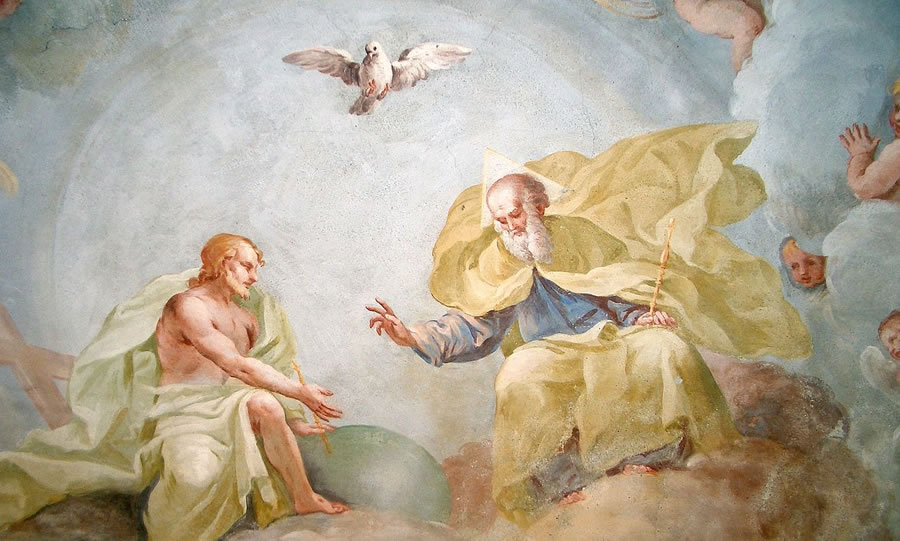
Solemnity of the Most Holy Trinity
by Fr. Michael D. Accinni Reinhardt, MA, Mdiv, MS | 06/15/2025 | Pastoral CornerComing off the heels of the Easter Season that culminated with Pentecost Sunday, the Church now gives us the first of two consecutive catechetical Sundays to instill in us a deeper love of our faith and the teachings of the Church. The Solemnity of the Most Holy Trinity speaks to us at the heart of God, in knowing Him at His foundation given in the Most Holy Trinity, Father, Son, and Holy Spirit. Throughout the centuries great debates have taken place over God as Three Persons, and the reality that the Sacred Trinity is a mystery and has been a mystery since the Church began to articulate it.
The Sacred Trinity has been explained since the late second century by Theophilus of Antioch. He is attributed to the late second century of early Church history, when describing the relationship of God’s mystery became known as a Trinity of three persons. By the 6th century St. Patrick became famous for his explanation of the Sacred Trinity when he used a mere shamrock, a sacred symbol of Ireland for centuries, but now with even more profound symbolism as so many embraced Christianity from Paganism because he described the Sacred Trinity to be like the shamrock with three distinct leaves yet one leaf.
One of the simplest ways we as Catholics engage the Sacred Trinity is by making the sign of the cross. To make the sign of the cross before Mass or when Mass ends is a gesture and testament to our faith. We receive the invocation and power of the completeness of God all at the same time by blessing ourselves in the name of the Father and of the Son, and of the Holy Spirit. The Sacred Trinity and the act of blessing ourselves is a powerful invocation that can be done at a moment’s notice, when we witness an accident, see a ball player on the field blessing himself, or we are faced with adversity or danger and need to beckon the power of God to come into the moment.
Think about the beauty of the Sacred Trinity today and contemplate these three distinct ways that it is possible to invoke the power of God in prayer and be filled with His holy wisdom and grace. How about we choose to invoke God more and more in this simple way when we are tempted to show the not too pretty sides of our nature? Instead of acting unkindly trade it in for the sign of the cross. Instead of speaking something that should not be spoken make the sign of the cross. Instead of blaring a temper make the sign of the cross.
Instead of casting verbal darts at people, make the sign of the cross, and be silent and receive the grace of the moment. The Sacred Trinity is meant to be invoked as a power against evil and our umbrella of protection.
Speak Kindness,
Father Michael
Solemnidad de la Santísima Trinidad
Tras el Tiempo de Pascua, que culminó con el Domingo de Pentecostés, la Iglesia nos ofrece ahora el primero de dos domingos catequéticos consecutivos para inculcar en nosotros un amor más profundo por nuestra fe y las enseñanzas de la Iglesia. La Solemnidad de la Santísima Trinidad nos habla desde el corazón de Dios, al conocerlo en su fundamento dado en la Santísima Trinidad: Padre, Hijo y Espíritu Santo. A lo largo de los siglos, se han suscitado grandes debates sobre Dios como Tres Personas y sobre la realidad de que la Santísima Trinidad es un misterio y lo ha sido desde que la Iglesia comenzó a expresarlo.
La Santísima Trinidad ha sido explicada desde finales del siglo II por Teófilo de Antioquía. Se le atribuye a finales del siglo II de la historia de la Iglesia primitiva, cuando la descripción de la relación del misterio de Dios se conoció como una Trinidad de tres personas. En el siglo VI, San Patricio se hizo famoso por su explicación de la Santísima Trinidad, utilizando un simple trébol, símbolo sagrado de Irlanda durante siglos, pero ahora con un simbolismo aún más profundo, ya que muchos abrazaron el cristianismo desde el paganismo. Describió la Santísima Trinidad como un trébol con tres hojas distintas, pero una sola.
Una de las maneras más sencillas en que los católicos nos conectamos con la Santísima Trinidad es haciendo la señal de la cruz. Hacer la señal de la cruz antes o al terminar la misa es un gesto y un testimonio de nuestra fe. Recibimos la invocación y el poder de la plenitud de Dios al mismo tiempo, bendiciéndonos en el nombre del Padre, del Hijo y del Espíritu Santo. La Santísima Trinidad y el acto de bendecirnos es una invocación poderosa que puede realizarse en cualquier momento: cuando presenciamos un accidente, vemos a un jugador de béisbol en el campo bendiciéndose, o nos enfrentamos a la adversidad o al peligro y necesitamos invocar el poder de Dios para que aparezca en el momento.
Piensa hoy en la belleza de la Santísima Trinidad y contempla estas tres maneras distintas de invocar el poder de Dios en oración y llenarte de su santa sabiduría y gracia. ¿Qué tal si elegimos invocar a Dios cada vez más de esta sencilla manera cuando nos sintamos tentados a mostrar nuestra naturaleza menos atractiva? En lugar de actuar con crueldad, cámbialo por la señal de la cruz. En lugar de decir algo que no debe decirse, haz la señal de la cruz.
En lugar de desahogarte, haz la señal de la cruz. En lugar de lanzar dardos verbales a la gente, haz la señal de la cruz, guarda silencio y recibe la gracia del momento. La Santísima Trinidad debe ser invocada como un poder contra el mal y nuestro paraguas protector.
Habla con bondad,
Padre Miguel